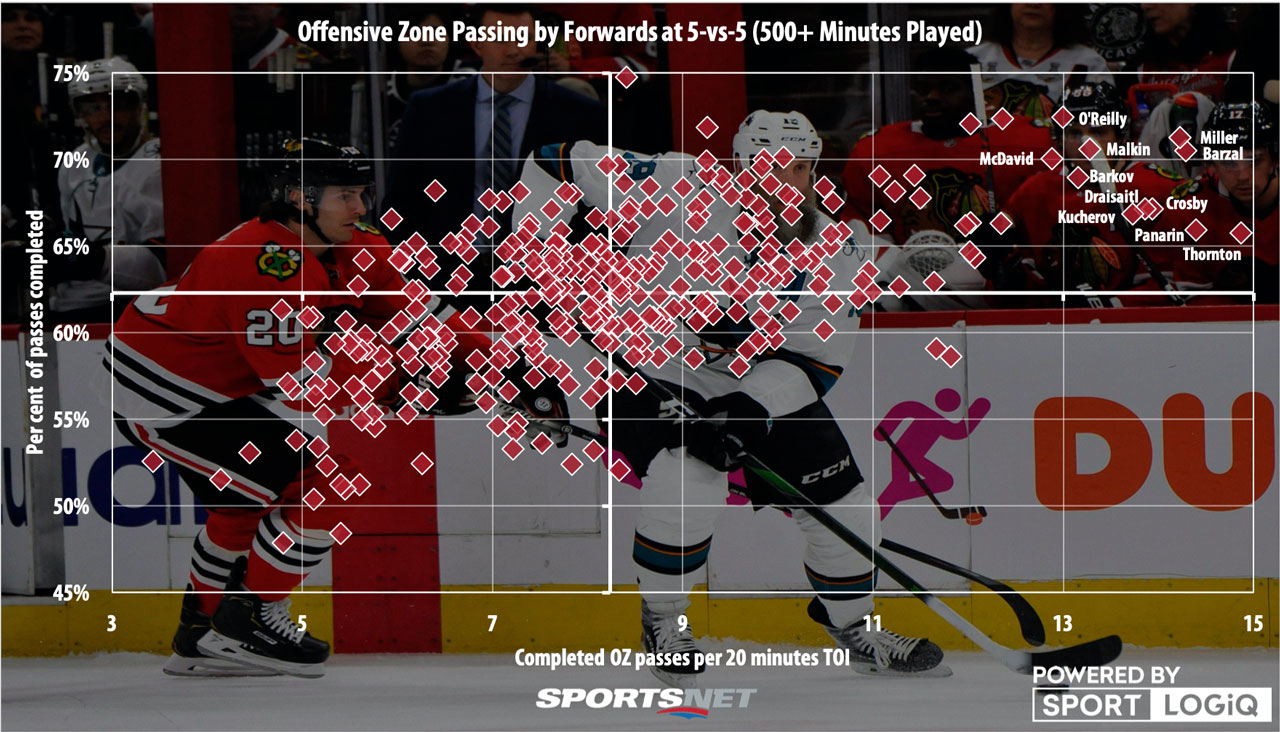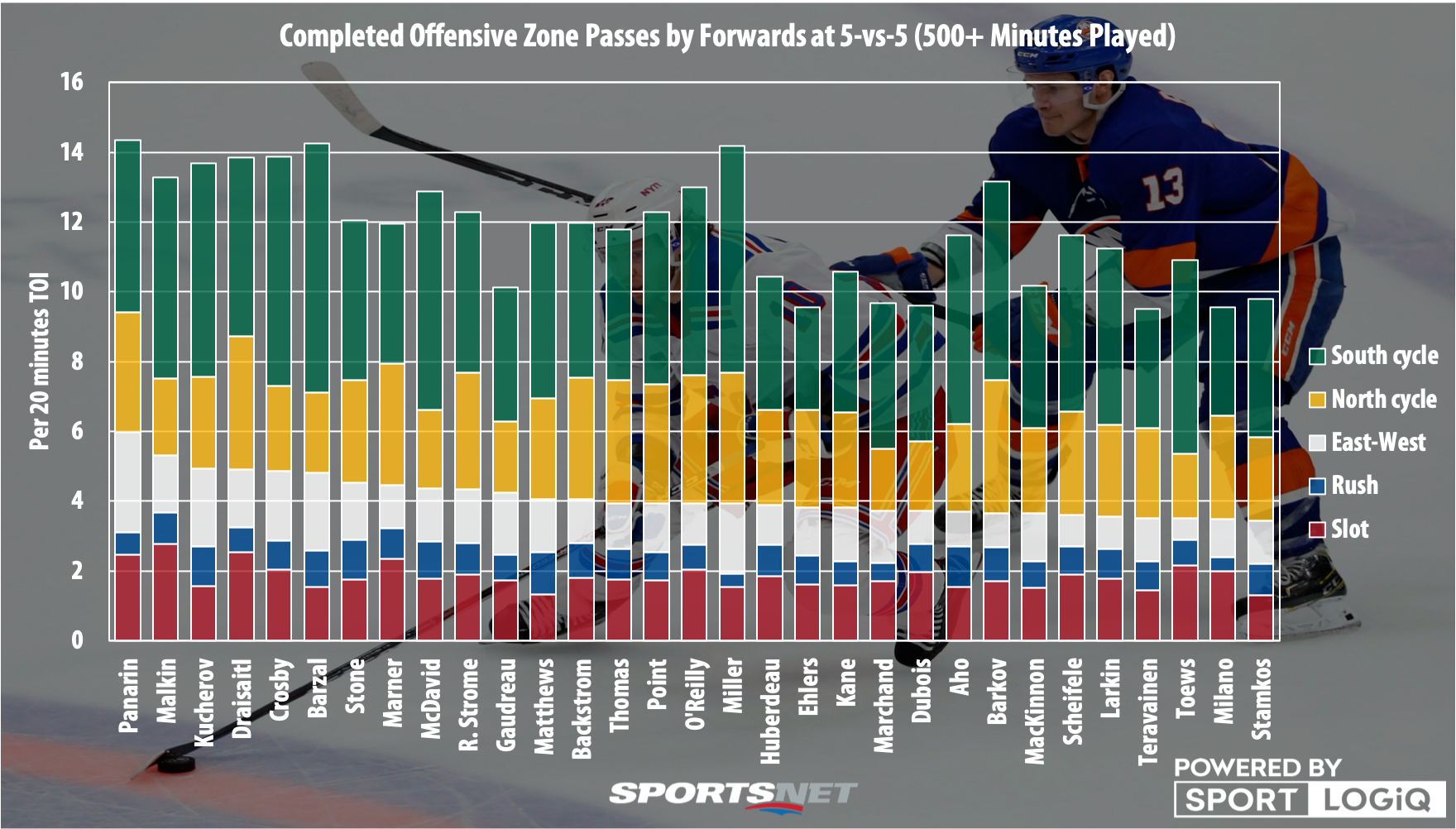After breaking down the best shooters at 5-vs-5 in the suspended 2019-20 NHL season, it’s time to take a look at the players who butter their bread; the playmakers.
Like the shooters, we’ve done this before, specifically at the beginning of the season using data from 2018-19, slicing the data we have available on offensive zone passing up to attempt to find the best 31 playmaking forwards after getting over the blue line.
Once again we’ll be using the cut off of 500 or more minutes played at 5-vs-5 in order keep things in a big enough sample that we can have confidence in the reliability of the data, and we’ll be using statistics pro-rated per 20 minutes of ice time in order to make sure we’re not missing those younger players who haven’t fully earned their coach’s trust as of yet, which as we know gives us a group of 336 forwards to look at.
Let’s start out with a general look at the volume of completed passes compared to how successful each player is at connecting on the offensive zone passes.

The cluster at the top for the playmakers is much tighter than it was for shooters, which made it a little bit more complicated to label, but with the axes set at league average numbers for both metrics, we can see the top group of playmakers in general in the top right of the graph.
Once again and always, Joe Thornton is the pass volume king. He’s not leading by as much as he was last season, but he is still yet to be overtaken. The other top players are a bunch of names you would probably expect; Artemi Panarin, Sidney Crosby, Leon Draisaitl, Nikita Kucherov, Mat Barzal, Aleksander Barkov, Evgeni Malkin, Ryan O’Reilly, Connor McDavid, and the surprisingly adept and underrated J.T. Miller.
There are some problems with evaluating things this generally though, for example, different players attempt different types of passes more often, and passes do not all carry the same expected completion rate. At the beginning of the year, I adjusted each player’s pass success rate weighted by the types of passes they completed and relative to the league average expected outcome, then separately adjusted for how difficult it was to make those passes in the specific team structure each player played in, but this time around I think we can do both at once.

Adjusting for difficulty and team structure, we get a much tighter grouping overall in the scatter plot, and the biggest reason for this is that the types of passes a player makes has a far greater influence on their overall pass success rate than the team structure they play within. There are outliers of course, but not many and they aren’t huge.
Adjusting pass success rate for difficulty and team structure puts Ryan O’Reilly as the most dependable playmaker to complete a pass in the NHL, followed closely by Brayden Point, Loui Eriksson, and Elias Lindholm.
Eriksson might be a surprising one since his career has really gone down the tubes in Vancouver, but the veteran just doesn’t mess up passes. He has a league-high 74.7 per cent success rate on his offensive zone passes, when the league average is about 62 per cent. The issue is, that doesn’t necessarily make him a great playmaker, does it? His volume of passes is just around league average, and even if we’re adjusting for difficulty, a player could look great hereby still making easier passes at a very high rate.
With that in mind, let’s look at the top-31 forwards in the league ordered by quality passes; namely those to the slot, off the rush, and through the middle of the ice East-West. Who sticks out as the most incisive offensive zone passer?

Just like last season, Panarin is the name that rushes to the top, as his ability to make cross-zone passes just blows away the competition. Malkin makes more passes to the slot, while Kucherov and a whole host of others are better playmakers off the rush, it’s Panarin who stands alone at the top when you combine all three.
For anyone thinking that O’Reilly might have just been spamming easy passes in the offensive zone, that isn’t the case. He ranks in the middle of this top group of forwards in quality passes, so he’s more than just a safe passer, he’s a high-end playmaker who rarely misses.
Knowing O’Reilly sits at the top of the pack in adjusted pass success rate though, where do the rest of these players compare? Let’s cut out the cycle passes and look just at the higher quality plays, and compare it to the relative success rates each player managed this season.

With only 31 players plotted, there’s a lot more space to be seen between them, and once again the further up and to the right a player would be, that’s the more potent their playmaking has been.
We know that O’Reilly will be the diamond furthest to the right, but how much more is that pass success rate worth if Panarin is completing nearly twice as many quality passes? To me, this debate comes down to two players; the pure volume of Artemi Panarin while remaining decidedly above average in success rates, or the combination of high volume and being nearly five and a half per cent better than expectations in success rates on the passes he makes that Malkin brings to the table.
To me, the extra accuracy that Malkin brings to the table, more than twice as far from league average in expectations than Panarin is, outweighs the gap in overall volume, so he would be the top 5-vs-5 playmaker in the league this year.
[relatedlinks]







